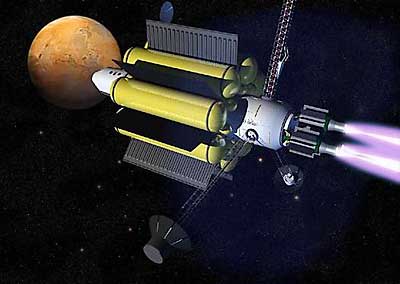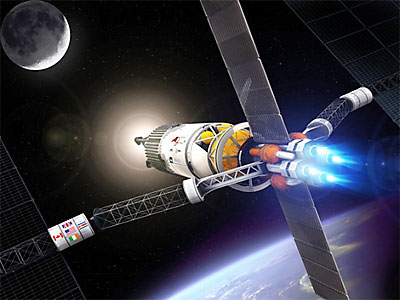Earth to Mars in a little over a month. Yes, you heard that right. Not the one-and-a-half-years there, one-and-a-half-years back, but around the Earth-Mars block in less than 80 days. (Credit: NASA/AdAstra)
How? By using a propulsion system orders-of-magnitude greater than current systems.
Meet VASIMR, the Variable Specific Impulse Magnetoplasma Rocket.
Mars isn’t really the only place that we can go. With a megawatt-class VASIMR, basically we will have access to the entire solar system. Mars is an interesting place, but so are Europa and Ganymede and Enceladus and Titan. These are places where we might find extraterrestrial life.
—Dr. Franklin Chang-Diaz [more]
Conventional Rockets vs. VASIMRs
Conventional rockets rely on the combustion of rocket fuel for propulsion; put otherwise, they rely on chemical reactions. (Credit: A&S Smithsonian/Ad Astra)

VASIMRs—antecedent to The Enterprise’s nacelles—rely on plasma for propulsion. Plasma—considered a distinct state of matter alongside solids, liquids, and gases—is a gas that has become ionized, often by extreme heat. Stars are made of plasma, as are lightening, polar aurorae, and most flames. (Credit: NASA)

How can something as hot as plasma be handled? With electromagnetic fields.
Superconductors create electromagnetic fields that contain the plasma, shape it into a jet, and point it in the right direction—out the back of the rocket. Nuclear reactions generate the electricity required.
How close is VASIMR to deployment?
A July 6, 2009 press release from the company developing VASIMR in collaboration with NASA reads:
Ad Astra Rocket Company has successfully demonstrated operation of its VX-200 plasma engine first stage at full power and under superconducting conditions in tests conducted today at the company’s Houston laboratory.
This achievement is a key milestone in the engine’s development and the first time a superconducting plasma rocket has been operated at that power level.

Videos of the AD Astra VASIMR full-power, full-field firing are at OnOrbit.com.
On September 30, 2009:
Ad Astra Rocket Company‘s VASIMR VX-200 rocket prototype reached its highly- coveted 200kW maximum power milestone at 11:59 am (CST) in tests conducted at the company’s Houston laboratory.
The DC power trace actually exceeded the design requirement by 1 kW and exhibited the clear signature of a well established plateau at peak power.
As announced on January 24, 2010:
After five years of operations, the company is maintaining a fast pace, focusing on maturing the VASIMR technology to flight readiness.
Even more exciting—if you are a VASIMR fan—the current administration has diverted billions of dollars from the earlier plans to return to the moon to better rocketry.

Chang-Diaz is planning for an orbital deployment by the end of 2013, and is already working with private space firms SpaceX and Orbital Science Corporation to make this a reality.
VASIMR Video
Great presentation by Dr. Franklin Chang-Diaz on YouTube (5 stars).
Wow—the firing of the VASIMR engine.
Air & Space Museum + Ad Astra: very cool silent Lunar Run video
VASIMR Online/Print
Down-to-earth interview with Dr. Franklin Chang-Diaz in SEED magazine.
NASA technical briefing: VASIMR.
Lots of information, images, etc. at the Ad Astra Rocket Company site.
Dr. Kirtland C. Peterson—”Cat” to his friends and colleagues—feeds his left brain with science, his right brain with the rich feast of fiction, including SF and fantasy. Among his life’s highlights are sitting in the pilot’s seat of a shuttle prepping for launch at the Kennedy Space Center, and accepting Brannon Braga’s invitation to pitch Star Trek scripts at Paramount in LA. Recently finished The Hobbit (read most marvelously by Rob Inglis), Ursula K. Le Guin’s A Wave in the Mind: Talks & Essays on The Writer, The Reader & The Imagination, and Alice Munro’s The View from Castle Rock. Just started J.R.R. Tolkein’s The Monsters and the Critics and Other Essays.










